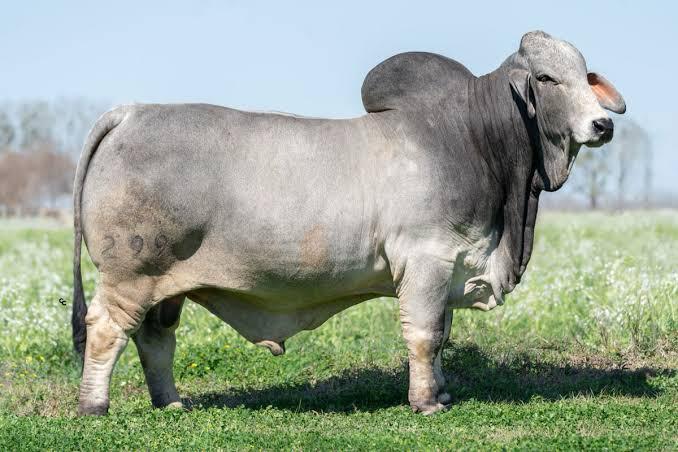
Brahman (Beef)
Brahman beef comes from the Brahman breed, known for its resilience, heat tolerance, and adaptability. Originating from India and popular in tropical climates, these cattle produce lean, flavorful meat. While often crossbred to enhance other beef lines, purebred Brahman beef is appreciated for its unique texture and lower fat content. Its distinct qualities make it a sought-after option in niche markets valuing hardiness and sustainability.
🐶 Pet Star
45 min read · 20, Apr 2025

Brahman (Beef): A Hardy, Resilient Breed for Modern Cattle Farming
The Brahman cattle breed, easily recognized by its distinctive hump over the shoulders, loose skin, and long ears, is one of the most iconic and resilient beef cattle breeds in the world. Originally developed in the United States from a mixture of Zebu cattle imported from India, the Brahman has become synonymous with hardiness, adaptability, and impressive beef production under harsh environmental conditions.
Origin and History
The Brahman breed traces its origins to the early 20th century in the southern United States, particularly Texas. The breed was developed from four principal Zebu breeds: Guzerat, Gir, Nelore, and Krishna Valley—all native to India and prized for their ability to thrive in hot, humid, and insect-ridden environments.
American breeders sought to develop a beef animal that could endure the extreme heat, high humidity, and poor-quality forage of the southern U.S. The result was the Brahman, a breed that not only adapted but excelled in these tough conditions.
Over time, the Brahman gained global popularity. It has been widely used in crossbreeding programs across Latin America, Australia, and Asia, giving rise to successful hybrids such as the Brangus (Brahman × Angus) and Braford (Brahman × Hereford).
Physical Characteristics
Brahman cattle have a distinctive appearance, shaped by thousands of years of natural and selective breeding.
- Color: Varies from light gray to red to nearly black, with light to medium gray being the most common. Bulls are generally darker than cows.
- Hump: A prominent feature is the muscular hump over the shoulders, primarily composed of muscle and connective tissue.
- Ears and Skin: Long, pendulous ears and loose, thick skin help regulate body temperature. The excess skin also provides a degree of resistance against insects.
- Size: Mature Brahman bulls typically weigh between 1,600 and 2,200 pounds, while cows range from 1,000 to 1,400 pounds.
These features make the Brahman highly suited to tropical and subtropical climates, where other breeds might suffer from heat stress or parasitic infections.
Temperament and Behavior
Brahman cattle are intelligent and curious animals, though they often get labeled as having a "nervous" temperament. In reality, their behavior is better described as alert and responsive. When treated gently and raised with regular human contact, Brahmans become docile and easy to manage. However, they can be protective of their calves, making them excellent mothers.
It's worth noting that Brahmans have a strong sense of self-preservation. This makes them more cautious or reactive in unfamiliar situations compared to more laid-back European breeds.
Adaptability and Hardiness
Brahmans are world-renowned for their ability to survive and thrive in environments where other cattle struggle. Their adaptability is attributed to several traits:
1. Heat Tolerance
One of the most celebrated traits of the Brahman breed is its extraordinary heat tolerance. Their skin has more sweat glands than European breeds, allowing better thermoregulation. The short, glossy coat reflects sunlight, while the light coloration also aids in temperature control.
2. Parasite Resistance
Thanks to their thick, oily skin and constant twitching ability, Brahmans are less susceptible to flies, ticks, and other parasites. Their immune systems are also highly efficient in combating diseases prevalent in tropical regions.
3. Forage Utilization
Brahman cattle can survive on sparse or low-quality forage better than most beef breeds. This makes them ideal for extensive grazing systems, especially in areas with erratic rainfall or poor soil fertility.
4. Longevity
These cattle are long-lived, often remaining productive well into their teens. Cows continue calving beyond 15 years of age, which enhances overall herd economics.
Meat Quality and Production
While Brahmans are primarily valued for their adaptability and role in crossbreeding, their beef characteristics have often been debated. Here are key factors:
- Carcass Yield: Brahman cattle have a high carcass yield due to their muscle development, especially in bulls.
- Meat Quality: Purebred Brahman beef is often lean and lower in marbling compared to British breeds like Angus or Hereford. However, it is still nutritious and flavorful when properly aged and prepared.
- Hybrid Vigor: Brahman-influenced crosses (e.g., Brangus, Braford, Simbrah) tend to produce high-quality beef while maintaining the hardiness of the Brahman parent.
Brahman genetics are often used in commercial operations not for their purebred meat, but to enhance hybrid vigor, improve heat tolerance, and increase reproductive longevity in crossbred herds.
Breeding and Reproduction
Brahman cattle are known for high fertility, excellent maternal instincts, and ease of calving. Key reproductive traits include:
- Early Maturity: Brahman heifers are generally bred at 18–24 months of age.
- Long Productive Life: Cows may produce calves annually for 12–15 years.
- Calving Ease: The breed tends to have fewer calving complications, with cows capable of delivering calves without much assistance.
Additionally, Brahman bulls are highly sought after for crossbreeding because of their dominant genetic impact on offspring performance.
Economic Importance and Global Influence
The Brahman breed is a cornerstone of the beef industry in tropical and subtropical regions around the globe. Its genetic traits have significantly contributed to cattle industries in:
- Brazil and Latin America: Widely used in creating composite breeds like the Nelore-Brahman cross.
- Australia: Extensively used in northern regions where environmental stress is high.
- Asia: Reintroduced to India and used in parts of Southeast Asia to improve native stock.
In the United States, Brahmans have carved out a niche in Southern beef production and as a genetic resource for crossbreeding in commercial herds.
Challenges of the Breed
Despite its strengths, the Brahman breed comes with some challenges:
- Meat Grading: Lower marbling often results in Brahman beef receiving lower USDA grades.
- Temperament Perception: They are sometimes perceived as more difficult to handle, especially if not properly socialized.
- Cold Sensitivity: Brahmans are not as cold-tolerant as British breeds, making them less suitable for northern climates.
Nevertheless, these challenges can be managed with proper handling, breeding strategies, and regional adaptation.
Brahman (Beef)
The Brahman breed, known for its distinct appearance and remarkable resilience, has carved a niche in global beef production, particularly in tropical and subtropical climates where other cattle breeds may struggle. Originating from the Zebu cattle of India, the Brahman was developed in the United States through the crossing of several Indian Zebu breeds, such as the Gir, Guzerat, Nelore, and Krishna Valley, which were imported for their hardiness in hot and humid environments. These cattle were selected for their ability to endure high temperatures, intense humidity, and limited forage, and over time, their genetic traits were refined to create a breed that could thrive in the southern U.S. conditions. The Brahman breed's physical features are distinctive and highly adapted to these harsh climates: its large hump, long pendulous ears, and loose skin help regulate body temperature and defend against insect pests. The hump, which is a muscular mass of tissue that stores fat, allows the animal to survive during periods of food scarcity, providing a valuable energy reserve. The loose skin increases surface area, which aids in heat dissipation, a vital feature for the breed's survival in areas prone to extreme heat. Brahman cattle come in a range of colors, from light gray to red, and the most common is light to medium gray, with bulls often being darker in color than cows. These cattle are highly adaptable, and their resistance to heat is unparalleled in the beef cattle industry, as they are less susceptible to heat stress than European breeds. Their coat is short and smooth, which helps in reducing the heat load, and their sweat glands are more efficient, further enhancing their ability to stay cool in hot conditions. This natural ability to withstand heat has made the Brahman a popular breed in hot, tropical regions such as South America, Southeast Asia, Australia, and Africa, where other cattle breeds may not survive. Brahmans are also resistant to pests and parasites, thanks to the oily nature of their skin, which repels flies, ticks, and other insects. This natural resistance reduces the need for chemical treatments and makes the breed an ideal candidate for sustainable and organic farming practices. Brahman cattle have proven to be very productive in low-input systems, thriving on poor-quality forage and requiring minimal supplementation. This makes them ideal for extensive grazing systems, where resources like high-quality feed and water may be limited. The breed’s ability to convert low-quality forage into meat efficiently is another factor that contributes to its popularity. In terms of size, Brahman bulls typically weigh between 1,600 to 2,200 pounds, while cows range from 1,000 to 1,400 pounds. Though they are not as large as some European beef breeds, their productivity is impressive given their physical adaptations. Brahman cattle are also highly fertile, with cows often calving at two years of age and continuing to produce offspring well into their teens, which significantly improves the economic efficiency of herds. Their maternal instincts are strong, and Brahman cows are known for being excellent mothers, providing adequate care to their calves even in challenging conditions. Despite their hardiness, Brahman cattle do have some perceived drawbacks. One common criticism is that their meat quality, while nutritious, is generally leaner and less marbled than that of other beef breeds like Angus or Hereford. This results in Brahman beef being less tender and flavorful when compared to these European breeds. However, it’s important to note that Brahman beef is still highly valued for its lean nature, and with proper care, nutrition, and aging techniques, the beef can be flavorful and tender. Furthermore, Brahman cattle are often not raised for purebred beef production but are instead used in crossbreeding programs, where their heat tolerance, disease resistance, and high productivity are combined with the carcass traits of European breeds. This results in hybrid offspring that are more resilient, and their beef tends to have better marbling and tenderness than purebred Brahman. The Brahman’s genetic influence is significant in producing hybrid cattle such as the Brangus (Brahman × Angus), Braford (Brahman × Hereford), and Simbrah (Brahman × Simmental), all of which exhibit improved performance across a range of traits, including growth rate, feed conversion efficiency, and disease resistance. These hybrids are especially valuable in regions with hot climates, where their Brahman parentage provides essential resilience against environmental stress. Additionally, Brahman cattle are known for their docility and intelligence, though they can be more sensitive and reactive compared to European breeds. When raised with proper handling and socialization, Brahmans tend to be calm and easy to manage. However, if they are mishandled or frightened, they may display skittish or nervous behavior, which is often misunderstood as aggression. Despite their strong survival instincts, Brahman cattle are very social and, with consistent care, they form strong bonds with their handlers and other animals. This breed’s longevity is another key factor in its success as a beef producer. Brahman cows can continue calving for 12 to 15 years, and even longer in some cases, which reduces the need for frequent replacements and helps maintain herd productivity. This makes the Brahman breed a cost-effective option for ranchers, especially those in regions where cattle are managed in extensive systems. With their resistance to disease, pests, and heat, Brahmans are a valuable asset in environments where other cattle may face challenges. Moreover, Brahman bulls are highly prized for their genetic contribution, as they produce offspring with desirable traits such as improved weight gain, disease resistance, and heat tolerance. In commercial herds, Brahman bulls are often used for natural breeding or their semen is utilized in artificial insemination programs to propagate their genetic traits. Globally, the Brahman breed has contributed to the development of beef production systems that can sustain both small-scale and large-scale operations. In countries like Brazil, Australia, and India, Brahman cattle are integral to beef production, and their crossbreeds are some of the most popular in the industry. In the United States, they are primarily found in southern states like Texas, Florida, and Alabama, where hot, humid conditions dominate. The Brahman’s presence in these regions ensures a reliable source of beef production, even in areas where other breeds may struggle. Furthermore, the breed’s adaptability is not just limited to its resistance to heat and disease. Brahmans are also able to handle variations in grazing conditions, from lush pastures to arid rangelands, making them versatile animals for different farming practices. However, Brahmans are not without their challenges. The primary concerns revolve around their meat quality, which may require additional attention in terms of nutrition and aging processes to ensure tenderness. In colder climates, the Brahman’s tolerance for low temperatures is limited, which means they may require additional care, such as shelter and feed supplementation, to thrive in such environments. Despite these drawbacks, the Brahman remains one of the most popular breeds for beef production, especially in areas where environmental conditions present significant challenges. Its hardiness, reproductive efficiency, and adaptability make it a breed that continues to shape the future of beef farming worldwide, ensuring its place as a foundational breed for sustainable beef production systems.
Brahman (Beef)
The Brahman is a remarkable breed of beef cattle known for its unique physical features, unmatched heat tolerance, and adaptability to challenging environments, making it an essential breed in global beef production systems, especially in tropical and subtropical climates. Originally developed in the United States during the early 20th century, the Brahman breed is the result of extensive crossbreeding between several Indian Zebu cattle such as Guzerat, Gir, Nelore, and Krishna Valley, all of which were brought to the U.S. between 1854 and the early 1900s. These Zebu cattle were naturally equipped to thrive in harsh environments, and American cattlemen saw an opportunity to create a beef breed that could withstand the high temperatures, intense humidity, insect pressure, and sparse forage common in the Southern U.S. The result of these breeding efforts was the Brahman—a tough, intelligent, and disease-resistant animal that has significantly influenced the global beef industry. One of the most striking features of the Brahman is its physical appearance: they typically have a pronounced hump over the shoulders, long pendulous ears, a loose dewlap, and abundant skin, all of which contribute to their exceptional heat regulation abilities. Their skin secretes an oily substance thought to be insect-repellent, and the loose skin helps with heat dissipation, giving them a unique evolutionary advantage in hot climates. Coat colors vary from light gray to red to almost black, but the most common are shades of light to medium gray, with bulls often being darker than cows. In terms of size, mature Brahman bulls generally weigh between 1600 and 2200 pounds, while cows range from 1000 to 1400 pounds. While they may not match some European breeds in terms of rapid weight gain or tenderness of meat, their resilience, fertility, longevity, and low maintenance needs make them invaluable in crossbreeding programs. The breed is renowned for its resistance to parasites, both internal and external, and diseases that commonly affect cattle in hot and humid regions. This genetic resistance significantly reduces the need for chemical interventions, which is a critical asset for sustainable and organic beef operations. In addition to their adaptability, Brahmans exhibit remarkable maternal qualities, with cows known for
Summary
The Brahman is a tough, adaptable beef breed that has revolutionized cattle farming in hot, challenging environments. With their distinctive appearance, resistance to pests and heat, and role in crossbreeding, Brahmans have made a lasting impact on global beef production. Their ability to thrive where other breeds fail makes them invaluable in regions where climatic stressors dominate.
Q&A section
Q1 :- What is the Brahman breed known for in beef production?
Ans:- Brahman cattle are known for their heat tolerance, disease resistance, and ability to thrive in harsh climates, making them valuable in beef production, especially in tropical regions.
Q2 :- How does Brahman beef compare in quality to other breeds?
Ans:- Brahman beef is typically leaner and may have less marbling than other breeds like Angus, but it is prized in crossbreeding for improving hardiness and meat yield.
Q3 :- Why are Brahman cattle commonly used in crossbreeding programs?
Ans:- They are used in crossbreeding to enhance traits like adaptability, fertility, and longevity in beef herds, improving overall herd performance.
Q4 :- What are some physical characteristics of Brahman cattle?
Ans:- Brahman cattle have a distinctive hump over their shoulders, loose skin, and long ears. Their light-colored coat helps reflect sunlight in hot climates.
Q5 :- What countries primarily use Brahman cattle for beef?
Ans:- Brahman cattle are widely used in the United States, Brazil, Australia, and India, particularly in regions with hot and humid climates.
Similar Articles
Find more relatable content in similar Articles

How Climate Change Affects Wild and Domestic Animals...
Climate change is dramatically.. Read More

Smart Homes for Pets: Automated Feeders, Doors, and Mo..
As smart home technology advan.. Read More

How Pets Strengthen Family Bonds...
Pets are more than just compan.. Read More

Sustainable Pet Products: What to Look for in 2025...
As sustainability becomes a ce.. Read More
Explore Other Categories
© 2024 Copyrights by rPets. All Rights Reserved.